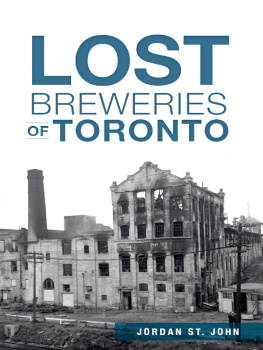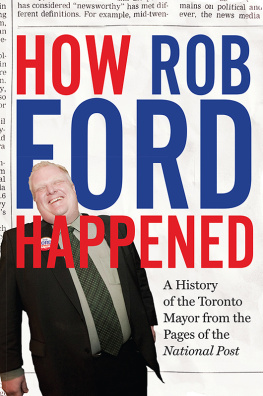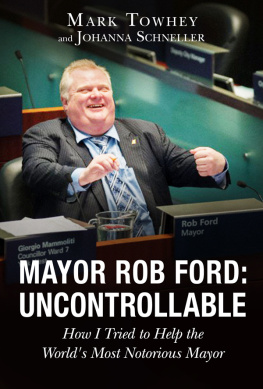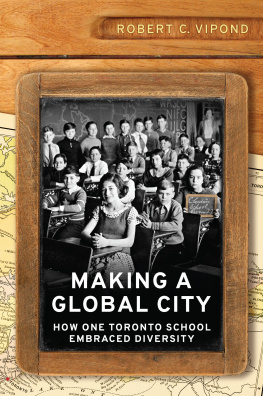copyright Edward Keenan, 2013
first edition
Published with the generous assistance of the Canada Council for the Arts and the Ontario Arts Council. Coach House Books also acknowledges the support of the Government of Canada through the Canada Book Fund and the Government of Ontario through the Ontario Book Publishing Tax Credit.
The opinions expressed in this book do not necessarily reflect those of Coach House Books.
LIBRARY AND ARCHIVES CANADA CATALOGUING IN PUBLICATION
Keenan, Edward, 1973-
Some great idea : good neighbourhoods, crazy politics and the invention of Toronto / Edward Keenan.
1. Toronto (Ont.)--Politics and government. 2. City planning-- Ontario--Toronto. 3. Ford, Rob, 1969-. 4. Toronto (Ont.)--History. I. Title.
eISBN 978-1-77056-326-1
I. Title.
FC 3097.4. K 44 2013971.3541 C 2012-908120-5
Some Great Idea is available as a print book: ISBN 978-1-55245-266-0.
All rights reserved. No part of this publication may be reproduced or transmitted in any form or by any means, electronic or mechanical, including photocopying, recording, or any information storage or retrieval system, without permission in writing from the publisher.
Distribution of this electronic edition via the internet or any other means without the permission of the publisher is illegal. Please do not participate in electronic piracy of copyright material; purchase only authorized electronic editions. We appreciate your support of the author's rights.
A great city, whose image dwells in the memory of man, is the type of some great idea. Rome represents Conquest; Faith hovers over the towers of Jerusalem; and Athens embodies the pre-eminent quality of the antique world, Art. In modern ages, Commerce has created London; while Manners, in the most comprehensive sense of the word, have long found a supreme capital in the airy and bright-minded city of the Seine.
Benjamin Disraeli,
Coningsby, or The New Generation
For Rebecca, without whom my idea of Toronto and most of my other ideas, too would be a lot less great.
AN INTRODUCTION: WHAT DOES TORONTO MEAN?
I have this notion that cities are just a collection of stories we tell ourselves about ourselves. At least in part. In a technical sense, a city is a location, a geographic area in which a lot of people live close to each other. And of course a city is also an administrative division that determines how those people manage to get along, or dont. A city is the setting for stories, sure, millions of them, public and private histories, biographies, comedies, tragedies, manifestos. But the city is also a character in those same stories, endowed with a history of its own, personality attributes, motivations and inner conflicts. The city that exists as a living body in our imaginations is not a passive set constructed for its players to act upon, but an active participant in the events that occur within it its mean streets and cold-hearted bureaucracy frustrate our hopes, its creative impulses and playful attitude entertain us, its generosity of spirit and inner resolve inspire us and offer us opportunities. And ultimately, a city is a story built from all the English 101 elements your teachers told you to expect: the narratives of New York, Paris, Detroit or Calgary each have an increasingly distinct arc composed of triumphs and defeats, conflicts resolved and conflicts festering that suggests to us what the city will do next, how we should interact with it, where it will take us and how it will define itself.
Im writing here about Toronto, an interesting case and a city thats sometimes defined as much by the brevity of its backstory and its hazy character traits as by its pre-eminence among Canadian urban areas or its agreeable nature. Its a Gatsby among municipalities. And Im writing about a time the decade and a half following the 1998 creation of the Toronto megacity in which the stories Toronto tells itself, and the various subplots lived by the people in it, have refused to converge into a coherent narrative. Under mayors Mel Lastman, David Miller and Rob Ford, Toronto appears to have been several places simultaneously, living separate and often contradictory even irreconcilable storylines.
To give you an idea of the place as it appeared to me in the middle of the time period Im talking about, heres one Toronto story. After work on June 15, 2005, a few of us from Eye Weekly (a now-defunct alt-weekly that morphed into The Grid , where I now work) wandered up through the late-afternoon sunshine to the Ultra Supper Club on Queen Street West for a Tourism Toronto campaign launch party. The room was full of black leather and dark wood and the kind of consciously articulated chuckling and business-card trading you see at a board-of-trade luncheon. Everyone was given logoed baseball caps and umbrellas as, onstage, a series of multi-ethnic dancers unveiled a new branding campaign, a couple years and a couple million dollars in the making. Toronto: Unlimited was the slogan, with the letters TO rolled into a single character that looked something like a stylized toilet seat.
My friends and I huddled near the bar, draining glasses of complimentary champagne and snatching tiger shrimp from the trays of passing servers. We cracked wise about the campaign. Maybe the logo looked like a spermatozoa? Was Unlimited supposed to sound as stiff and corporate as it did? Or as generic? In retrospect, it wasnt a half-bad campaign, based on neighbourhood profiles that highlighted Torontos ethnic enclaves, but it was the era of No Logo and anything as self-conscious as a branding campaign seemed worthy of disdain. I was already drafting a snarky editorial in my head as our crowd retired to the rooftop patio to discuss current events and watch the sun set. The federal government under Prime Minister Paul Martin was finally going to insist on passing legislation recognizing same-sex marriages, a gift just in time for the massive Toronto Pride festival coming up a week or so later, and one expected to result in thousands of Americans rushing into town to get hitched at city hall. Meanwhile, it looked like Mayor David Miller, at long last, would persuade the province to grant new powers to the city so it could become a grown-up government. We debated the merits of a strong mayor system; Miller didnt want extraordinary executive power, but I thought maybe he should.
Night was falling and the regular crowd of Bay Streeters started trickling into the bar. I wandered up Beverley Street with Matt Blackett, the publisher of the then-fledgling urbanist magazine Spacing , to a converted mansion where a literary magazine party was winding down. A couple of editors there had liberated a bottle of wine from the bar and invited us to enjoy it with them across the street. We sat on a picnic table in Grange Park just a few hundred metres from where Id taken piano lessons as a kid and swigged from the bottle. We could see the new Ontario College of Art & Design building from there, Will Alsops weird and wonderful tabletop structure that looked like a shoebox floating in the air atop massive, brightly coloured crayons. And we could see the work underway on Frank Gehrys addition to the Art Gallery of Ontario, where a new spiral staircase would face out onto the park. I invited Matt and our new friends to a dance party I was holding in a Queen West bar that week a few pals and I had decided wed like to be nightclub DJ s and had started hosting monthly events that, to our surprise, had suddenly become popular. It turned out the literary magazine editors were already planning to attend, and it also turned out we were out of wine, so we all wandered up to Baldwin Street to meet more friends at an Italian restaurant.









